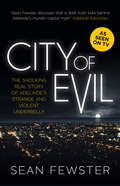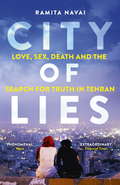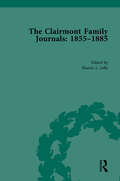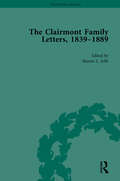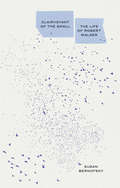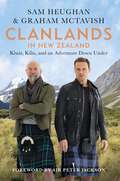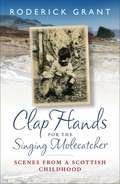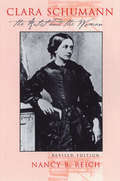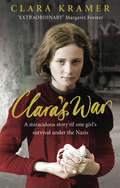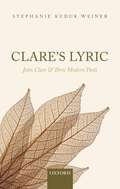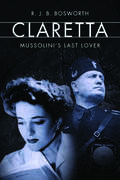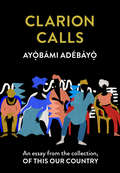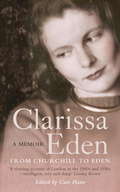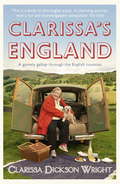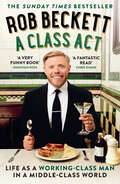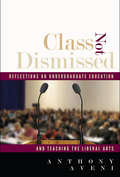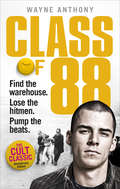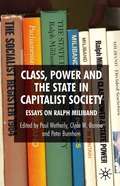- Table View
- List View
City of Evil: The shocking real story of Adelaide's strange and violent underbelly - As seen on TV
by Sean FewsterNOW A MAJOR TELEVISION SERIESThey call Adelaide the city of churches. What they forget is that every church has a graveyard - and every graveyard is full of skeletons.Adelaide, an elegantly designed, civilised city, where the inhabitants are known for their love of the arts, good food and fine wine, is also the place where many of Australia's most bizarre and macabre crimes have taken place.The cases in this book show that Adelaide truly does have another side: from the murder of a pro-wrestling truck driver by his two lesbian lodgers during an argument over a camera; to the case of a wronged wife who only wanted to burn the penis of her unfaithful husband, not burn him to death...This book is more than a collection of some of the most attention-grabbing, shocking and puzzling cases from the past ten years: it also looks at why it might be that so many have happened in this sunny, conservative, unassuming state capital.Praise for City of Evil:'Sean Fewster discovers that a dark truth lurks behind Adelaide's murder capital myth' - Adelaide Advertiser'a collection of macabre murders, rapes, torture and robbery, all occurring in Adelaide, the "City of Churches"...sensational and gruesome' - Courier Mail'This book is not for the squeamish, but if you love true crime stories then this is right up there with the best of them' - Toowoomba Chronicle
City of Lies: Love, Sex, Death and the Search for Truth in Tehran
by Ramita NavaiLying in Tehran is about survival. Welcome to Tehran, a city where survival depends on a network of subterfuge. Here is a place where mullahs visit prostitutes, drug kingpins run crystal meth kitchens, surgeons restore girls' virginity and homemade porn is sold in the sprawling bazaars; a place where ordinary people are forced to lead extraordinary lives. Based on extensive interviews, CITY OF LIES chronicles the lives of eight men and women drawn from across the spectrum of Iranian society and reveals what it is to live, love and survive in one of the world's most repressive regimes.
Cityboy: Beer and Loathing in the Square Mile
by Geraint AndersonCITYBOY is Geraint Anderson's bestselling exposé of life in the City of London.In this no-holds-barred, warts-and-all account of life in London's financial heartland, Cityboy breaks the Square Mile's code of silence, revealing tricks of the trade and the corrupt, murky underbelly at the heart of life in the City. Drawing on his experience as a young analyst in a major investment bank, the six-figure bonuses, monstrous egos, and the everyday culture of verbal and substance abuse that fuels the world's money markets are brutally exposed as Cityboy describes his ascent up the hierarchy of this intensely competitive and morally dubious industry, and how it almost cost him his sanity.
Civil War Barons: The Tycoons, Entrepreneurs, Inventors, and Visionaries Who Forged Victory and Shaped a Nation
by Jeffry D. WertBefore the robber barons there were Civil War barons--a remarkable yet largely unknown group of men whose contributions won the war and shaped America's future. The Civil War woke a sleeping giant in America, creating unprecedented industrial growth that not only supported the struggle but reshaped the nation. Energized by the country's dormant potential and wealth of natural resources, individuals of vision, organizational talent, and capital took advantage of the opportunity that war provided. Their innovations sustained Union troops, affected military strategy and tactics, and made the killing fields even deadlier. Their ranks included men such as:John Deere, whose plows helped feed large armiesGail Borden, whose condensed milk nourished the Union armyThe Studebaker Brothers, whose wagons moved war supplies from home front to war frontRobert Parrott, whose rifled cannon was deployed on countless battlefields. and many others. Individually, these men came to dominate industry and amass great wealth and power; collectively, they helped save the Union and refashion the economic fabric of a nation. Utilizing extensive research in manuscript collections, company records, and contemporary newspapers, historian Jeffry D. Wert casts a revealing light on the individuals most responsible for bringing the United States into the modern age.
The Clairmont Family Journals 1855-1885
by Sharon JoffeThis edition presents the extant journals of Pauline Clairmont (1825–1891) and Wilhelm Clairmont (1831–1895), the niece and nephew of Claire Clairmont (1798–1879) who was Mary Shelley’s (1797–1851) stepsister. It also includes a journal originally attributed to Pauline but which likely was Walter Gaulis Clairmont’s (1868–1958; Wilhelm’s son). All three journals are currently deposited in the Carl H. Pforzheimer Collection of Shelley and His Circle at the New York Public Library. Pauline and Wilhelm spent many years living and working in places like Australia and the Banat and their adventures are recorded in their journals. Pauline wrote a series of sixteen journals cataloguing her life; however, except for one journal, all the remaining journals have been lost. Her extant journal, written primarily in English but with French and German entries, documents her struggles in the Australian outback during the 1850s and her relationship with William Henry Suttor, Junior, who would later become a pastoralist and a politician. Pauline’s journal tells of her love for Suttor, her disappointment at his rejection, and her musings about her life in Australia. In his journal, Wilhelm chronicles his attempts to purchase a farm in Europe while Walter provides us with an account of his 8-day Austrian expedition. This new edition brings together these three journals, thereby extending our understanding of the Shelley-Clairmont family. The edition includes an introduction to the primary Godwin-Shelley-Clairmont circle and a chapter on the history of life writing. The editor provides extensive editorial notes and carefully researched chapters to contextualize The Clairmont Family Journals: 1855–1885.
The Clairmont Family Journals 1855-1885
by Sharon JoffeThis edition presents the extant journals of Pauline Clairmont (1825–1891) and Wilhelm Clairmont (1831–1895), the niece and nephew of Claire Clairmont (1798–1879) who was Mary Shelley’s (1797–1851) stepsister. It also includes a journal originally attributed to Pauline but which likely was Walter Gaulis Clairmont’s (1868–1958; Wilhelm’s son). All three journals are currently deposited in the Carl H. Pforzheimer Collection of Shelley and His Circle at the New York Public Library. Pauline and Wilhelm spent many years living and working in places like Australia and the Banat and their adventures are recorded in their journals. Pauline wrote a series of sixteen journals cataloguing her life; however, except for one journal, all the remaining journals have been lost. Her extant journal, written primarily in English but with French and German entries, documents her struggles in the Australian outback during the 1850s and her relationship with William Henry Suttor, Junior, who would later become a pastoralist and a politician. Pauline’s journal tells of her love for Suttor, her disappointment at his rejection, and her musings about her life in Australia. In his journal, Wilhelm chronicles his attempts to purchase a farm in Europe while Walter provides us with an account of his 8-day Austrian expedition. This new edition brings together these three journals, thereby extending our understanding of the Shelley-Clairmont family. The edition includes an introduction to the primary Godwin-Shelley-Clairmont circle and a chapter on the history of life writing. The editor provides extensive editorial notes and carefully researched chapters to contextualize The Clairmont Family Journals: 1855–1885.
The Clairmont Family Letters, 1839 - 1889 (The Pickering Masters)
by Sharon JoffeThis edited collection brings together the unpublished letters of the extended Clairmont family, for the first time. The letters, housed in the Carl H. Pforzheimer Collection of Shelley and His Circle at the New York Public Library, inform our understanding of the Shelley-Godwin circle through the experiences and thoughts of their descendants. The correspondence also enables us to see into the contemporary social history of nineteenth-century families living in Europe and Australia, dealing with subjects such as the conflicts in Europe, woes in the European financial markets, and the effects of Australian pioneer life on immigrants to that country. The Clairmont Family Letters, 1839–1889 improves upon scholarship made by other Shelley and Clairmont collections and is furnished with editorial notes and apparatus from Dr. Sharon Joffe. These volumes will be of significant interest to scholars in British Romanticism.
Clairvoyant of the Small: The Life of Robert Walser
by Susan BernofskyThe first English-language biography of one of the great literary talents of the twentieth century, written by his award-winning translator“Bernofsky takes us into the heart of an artist’s life/work struggles, brilliantly illuminating Walser’s exquisite sensibility and uncompromising radical innovations, while deftly tracking how his life gradually came apart at the seams. A tragic and intimate portrait.”—Amy Sillman “Robert Walser is the perfect pathetic poet: pithy, awkward, drinks too much, sibling rivalrous, ambitious, broke, and mentally ill. Was he proto queer or trans, this red headed writer who next to Gertrude Stein might be the most influential writer of our moment? Riveting and heart-breaking, this biography kept me drunk for days.”—Eileen Myles The great Swiss-German modernist author Robert Walser lived eccentrically on the fringes of society, shocking his Berlin friends by enrolling in butler school and later developing an urban-nomad lifestyle in the Swiss capital, Bern, before checking himself into a psychiatric clinic. A connoisseur of power differentials, his pronounced interest in everything inconspicuous and modest—social outcasts and artists as well as the impoverished, marginalized, and forgotten—prompted W. G. Sebald to dub him “a clairvoyant of the small.” His revolutionary use of short prose forms won him the admiration of Franz Kafka, Walter Benjamin, Robert Musil, and many others. He was long believed an outsider by conviction, but Susan Bernofsky presents a more nuanced view in this immaculately researched and beautifully written biography. Setting Walser in the context of early twentieth century European history, she provides illuminating analysis of his extraordinary life and work, bearing witness to his “extreme artistic delight.&rdquo
Clanlands in New Zealand: Kiwis, Kilts, and an Adventure Down Under
by Sam Heughan Graham McTavish*With a foreword by Sir Peter Jackson*Buckle up, grab a dram, and get ready for another unforgettable wild ride.They're back! Stars of Outlander, Sam Heughan and Graham McTavish are no strangers to the rugged beauty of Scotland. But this time they're setting their sights on a new horizon: New Zealand.Join our intrepid Scotsmen on their latest epic adventure across The Land of the Long White Cloud in this thrilling follow-up to Clanlands. Setting out to explore a country that Graham calls home, and that Sam has longed to visit, these sturdy friends immerse themselves in all that New Zealand has to offer: stunning landscapes, rich history, world-class food and drink, and - much to Graham's mounting anxiety and Sam's deep satisfaction - famously adrenaline-fuelled activities! As ever there's not nearly enough space in their trusty camper van and with plenty of good-natured competition and tormenting to go around, Sam and Graham's friendship is put to the test once again. Along the way we learn about the length and breadth of this jewel of the Southern Seas, exploring the fascinating story of its people while testing the very limits of Graham's sanity.Like the very best buddy movie sequel, this latest instalment is full of unforgettable experiences and loveable characters and promises to be an even more memorable ride with two of the most entertaining travel companions around.So, say goodbye to your inhibitions and kia ora to New Zealand like you've never seen it before.
Clap Hands for the Singing Molecatcher: Scenes from a Scottish Childhood
by Roderick GrantPresents an account of the writer's childhood on a remote country estate in Morayshire in the 1940s and 1950s; a place where isolated hill farms, limitless moorland and the rock-strewn banks of wild, tumbling rivers became the backdrop for a variety of adventures and experiences. Laughter, tragedy and dramatic incident thread their way through the life of a growing boy and the lives of the people he observes. Roderick Grant's book is not merely one of nostalgic recall. It is a richly evocative memoir of a time and place when horses still drew ploughs and children walked seven miles or more each day to reach their school; and where shepherd and gamekeeper, farmer and labourer, forester, railway worker, teacher, laird and minister, and their families, were all part of a community, close-knit in its isolation from the changing post-war world.
Clara: A Novel
by Janice GallowayJanice Galloway's new novel is based on the life of Clara Schumann: celebrated nineteenth-century concert pianist and composer, editor and teacher, friend of Brahms - who was also the wife of Robert Schumann, the mother of his eight children, and the woman who cared for him through a series of crippling mental illnesses. Clara is a lyrical and vibrant account of two remarkable and highly dramatic musical careers, but primarily it is a novel about timeless, common things: about the inescapable influences of childhood, about creativity and marital life, about communication and silence, about how art is made and how art, in turn, may erode or save the life that nourishes it.
Clara Schumann: The Artist and the Woman (Dover Music For Piano Ser.)
by Nancy ReichThis absorbing and award-winning biography tells the story of the tragedies and triumphs of Clara Wieck Schumann (1819–1896), a musician of remarkable achievements. At once artist, composer, editor, teacher, wife, and mother of eight children, she was an important force in the musical world of her time. To show how Schumann surmounted the obstacles facing female artists in the nineteenth century, Nancy B. Reich has drawn on previously unexplored primary sources: unpublished diaries, letters, and family papers, as well as concert programs. Going beyond the familiar legends of the Schumann literature, she applies the tools of musicological scholarship and the insights of psychology to provide a new, full-scale portrait.The book is divided into two parts. In Part One, Reich follows Clara Schumann's life from her early years as a child prodigy through her marriage to Robert Schumann and into the forty years after his death, when she established and maintained an extraordinary European career while supporting and supervising a household and seven children. Part Two covers four major themes in Schumann's life: her relationship with Johannes Brahms and other friends and contemporaries; her creative work; her life on the concert stage; and her success as a teacher.Throughout, excerpts from diaries and letters in Reich's own translations clear up misconceptions about her life and achievements and her partnership with Robert Schumann. Highlighting aspects of Clara Schumann's personality and character that have been neglected by earlier biographers, this candid and eminently readable account adds appreciably to our understanding of a fascinating artist and woman.For this revised edition, Reich has added several photographs and updated the text to include recent discoveries. She has also prepared a Catalogue of Works that includes all of Clara Schumann's known published and unpublished compositions and works she edited, as well as descriptions of the autographs, the first editions, the modern editions, and recent literature on each piece. The Catalogue also notes Schumann's performances of her own music and provides pertinent quotations from letters, diaries, and contemporary reviews.
Clara's War: A Young Girl's True Story Of Miraculous Survival Under The Nazis
by Clara KramerOn 21 July 1942 the Nazis took control of the small Polish town of Zolkiew, life for Jewish 15-year-old Clara Kramer was never to be the same again. While those around her were either slaughtered or transported, Clara and her family hid perilously in a hand-dug bunker. Living in the house above and protecting them were the Becks.Mr Beck was a womaniser, a drunkard and a self-professed anti-Semite, yet he risked his life throughout the war to keep his charges safe. Nevertheless, life with Mr Beck was far from predictable. From the house catching fire, to Beck's affair with Clara's cousin, to the nightly SS drinking sessions in the room just above, Clara's War transports you into the dark, cramped bunker, and sits you next to the families as they hold their breath time and again.Sixty years later, Clara Kramer has created a memoir that is lyrical, dramatic and heartbreakingly compelling. Despite the worst of circumstances, this is a story full of hope and survival, courage and love.
Clare's Lyric: John Clare And Three Modern Poets
by Stephanie Kuduk WeinerThis book considers the lyric poems written by John Clare and three twentieth-century poets—Arthur Symons, Edmund Blunden, and John Ashbery—who turned to him at pivotal moments in their own development. These writers crafted a distinctive mode of lyric, 'Clare's lyric', that emphatically grounds its truth claims in mimetic accuracy. For these writers, accurate representation involves not only words that name objects, describe scenes, and create images pointing to a shared reality but also patterns of sound, the syntactic organization of lines, and the shapes of whole poems and collections of poems. Their works masterfully investigate how poetic language and form can refer to the world, word by word, line by line, and poem by poem. Written in a lively and accessible style, Clare's Lyric sheds light on a richly diverse body of poems and on enduring questions about how literature represents reality. Weiner's attentive close readings bring the writings of Clare, Symons, Blunden, and Ashbery to life by revealing precisely how they captured a vital, arresting, and complex world in their poems. Their unique approach to lyric is traced from Clare's poems about birdsong, his sonnets, and his later poems of loss and absence to Symons's efforts to make 'amends to nature' Blunden's vivid depictions of a European and English countryside scarred by the First World War, and Ashbery's unbounded and bountiful landscapes. This inventive study refines our understanding of the aesthetic of Romanticism, the genre of lyric, and the practice of literary representation, and it makes a compelling case for the ongoing importance of poems about nature and social life.
Claretta: Mussolini's Last Lover
by R. J. BosworthA master historian illuminates the tumultuous relationship of Il Duce and his young lover Claretta, whose extraordinarily intimate diaries only recently have become available Few deaths are as gruesome and infamous as those of Benito Mussolini, Italy’s fascist dictator, and Claretta (or Clara) Petacci, his much-younger lover. Shot dead by Italian partisans after attempting to flee the country in 1945, the couple’s bodies were then hanged upside down in Milan’s main square in ignominious public display. This provocative book is the first to mine Clara’s extensive diaries, family correspondence, and other sources to discover how the last in Mussolini’s long line of lovers became his intimate and how she came to her violent fate at his side. R. J. B. Bosworth explores the social climbing of Claretta’s family, her naïve and self-interested commitment to fascism, her diary’s graphically detailed accounts of sexual life with Mussolini, and much more. Brimful of new and arresting information, the book sheds intimate light not only on an ordinary-extraordinary woman living at the heart of Italy’s totalitarian fascist state but also on Mussolini himself.
Clarice Cliff
by Lynn KnightClarice Cliff was one of the most prominent ceramic designers of the twentieth century. Born in 1899 in the Staffordshire Potteries, she started work as just another factory girl, but by 1928 had launched her own range of pottery, 'Bizarre'. A 'gargantuan feast of colour', it blazed a trail through the homes of inter-war Britain. But if Clarice Cliff's rise from apprentice gilder to art director was remarkable - and all the more so for her being a woman - it was not without its tensions; for years she conducted a secret relationship with her married boss. Fusing art, design and industry and vividly conveying the texture of women's lives between the wars, this is a compelling study of the complex, talented woman whose work is for many the epitome of art deco.
Clarion Calls: An Essay From The Collection, Of This Our Country
by Ayọ̀bámi Adébáyọ̀To define Nigeria is to tell a half-truth. Many have tried, but most have concluded that it is impossible to capture the true scope and significance of Africa’s most populous nation through words or images.
Clarissa Eden: A Memoir - From Churchill To Eden
by Clarissa EdenA Memoir by Clarissa Eden, born a Churchill and a Prime Minister's wife at the age of 34.In 1955, at the astonishingly young age of 34, Clarissa Eden entered No. 10 Downing Street as the wife of the new Prime Minister, Anthony Eden. Born Clarissa Churchill in 1920, her uncle was the great Winston, and when she married the 55-year-old Eden, then Foreign Secretary, at Caxton Hall register office in 1952, there were crowds as big as the gathering that had cheered Elizabeth Taylor and Michael Wilding's wedding there six months earlier.A renowned beauty, she was at home with her mother's Liberal intellectual circle, and mixed in her youth with the pillars of Oxford's academic community - Isaiah Berlin, Maurice Bowra and David Cecil among them: according to Antonia Fraser, she was 'the don's delight because she was beautiful and extremely intellectual'. Her close circle of friends included some of the leading cultural figures of the twentieth century: Cecil Beaton, Evelyn Waugh, Orson Welles among them. Her observations and insights into these men and their world provide a unique window into the mid 20th century. As the spouse of the most important man in Britain, the hostess at No. 10 and Chequers, Clarissa Eden was inevitably privy to a multitude of top-level secrets. The Suez crisis and Eden's ill health meant that she shared just four years of Anthony's political life and eighteen months as Prime Minister's wife. This individual, discriminating and honest memoir is her first account of extraordinary times, intuitively edited by Cate Haste, co-author of The Goldfish Bowl.
Clarissa's England: A gamely gallop through the English counties
by Clarissa Dickson WrightThe quintessential Englishwoman Clarissa Dickson Wright, one of the Two Fat Ladies and author of Spilling the Beans, takes us on a personal journey through the country of her birth.From Cornwall to Cumbria, Norfolk to Northumbria she brings her extraordinary knowledge, huge passion, forthright opinions and inimitable wit to the distinctive history and regional character of every corner of England.In her cornucopia of local knowledge she reveals, for example, how Boudicca was the original Essex girl, that Lincolnshire has a coriander crop second only in size to India's, and just why a Cornish pasty should never contain carrots.As much an entertaining narrative as it is a travel companion, Clarissa's England will amuse, enlighten, surprise and delight all those who read it.
A Class Act: Life As A Working-class Man In A Middle-class World
by Rob Beckett‘Pacy, witty and affectionate’ Guardian Rob Beckett never seems to fit in. At work, in the middle-class world of television and comedy, he’s the laddie, cockney geezer, but to his mates down the pub in south-east London, he’s the theatrical one, a media luvvie. Even at home, his wife and kids are posher than him.
Class Lives: Stories from across Our Economic Divide (A Class Action Book)
by Chuck Collins Jennifer Ladd Maynard Seider Felice YeskelClass Lives is an anthology of narratives dramatizing the lived experience of class in America. It includes forty original essays from authors who represent a range of classes, genders, races, ethnicities, ages, and occupations across the United States. Born into poverty, working class, the middle class, and the owning class—and every place in between—the contributors describe their class journeys in narrative form, recounting one or two key stories that illustrate their growing awareness of class and their place, changing or stable, within the class system. The stories in Class Lives are both gripping and moving. One contributor grows up in hunger and as an adult becomes an advocate for the poor and homeless. Another acknowledges the truth that her working-class father’s achievements afforded her and the rest of the family access to people with power. A gifted child from a working-class home soon understands that intelligence is a commodity but finds his background incompatible with his aspirations and so attempts to divide his life into separate worlds. Together, these essays form a powerful narrative about the experience of class and the importance of learning about classism, class cultures, and the intersections of class, race, and gender. Class Lives will be a helpful resource for students, teachers, sociologists, diversity trainers, activists, and a general audience. It will leave readers with an appreciation of the poignancy and power of class and the journeys that Americans grapple with on a daily basis.
Class Not Dismissed: Reflections on Undergraduate Education and Teaching the Liberal Arts
by Anthony AveniIn Class Not Dismissed, award-winning professor Anthony Aveni tells the personal story of his six decades in college classrooms and some of the 10,000 students who have filled them. Through anecdotes of his own triumphs and tribulations—some amusing, others heartrending—Aveni reveals his teaching story and thoughts on the future of higher education. Although in recent years the lecture has come under fire as a pedagogical method, Aveni ardently defends lecturing to students. He shares his secrets on crafting an engaging lecture and creating productive dialogue in class discussions. He lays out his rules on classroom discipline and tells how he promotes the lost art of listening. He is a passionate proponent of the liberal arts and core course requirements as well as a believer in sound teaching promoted by active scholarship. Aveni is known to his students as a consummate storyteller. In Class Not Dismissed he shares real stories about everyday college life that shed light on serious educational issues. The result is a humorous, reflective, inviting, and powerful inquiry into higher education that will be of interest to anyone invested in the current and future state of college and university education.
Class of '88: Find the warehouse. Lose the hitmen. Pump the beats.
by Wayne AnthonyOrganised crime puts on a smiley face.When the Summer of Love hit Britain in ’88, Wayne embraced the bright new world of dance music, MDMA and all-night celebrations. But alongside the ecstasy, his natural East End entrepreneurial instincts kicked in, and he began to organise the infamous Genesis dance parties for thousands of kids. Wayne soon became a key figure in the high octane, technicolour rave scene. But beneath the shiny, smiley surfaces, he quickly found himself in a vicious world of violence, police harassment and organised crime, for which he was totally unsuited and unprepared. He was beaten by ex-paratroopers, menaced by gangsters, kidnapped, confronted with sawn off shotguns and threatened with murder, all so Britain could party like never before.When Class of ’88 was first published, it was so popular that Foyles dedicated an entire window to the book for a month. Now, re-issued for the 30th anniversary, this is Wayne’s very lively, highly individual account of the two years he spent as an illegal party promoter, leading the rave revolution which was sweeping the UK, changing lives, music and popular culture forever.
A Class of Their Own: Adventures in Tutoring the Super-Rich
by Matthew Hammett Knott'A hilarious account of life with the children of the super rich...well written...and very funny indeed' - BOOK OF THE WEEKDaily Mail'A hilarious, behind-the-scenes memoir of the mad world of the very rich' Daily Telegraph'There are so many laughs in this book, you almost forget how upsetting capitalism is' Simon AmstellA naked Russian oligarch is spanking me in his basement. His weapon is a birch branch, the setting his luxurious home sauna. Above us is 30,000 square feet of one of Moscow's most obscene private homes, an original Damien Hirst above the fireplace, a vacuum cleaning system built into the skirting boards. Invisible speakers serenade us with a desolate pan pipe cover of 'Bridge Over Troubled Water'. A light display rotates kaleidoscopically, illuminating the oligarch's genitals in a variety of unexpected hues. Everyone is silent. Then the oligarch's son Nikita looks at me with a mysterious smile.'Now my mother will bring us honey.'Matt Knott spent over a decade traveling the globe as a private tutor. He has taught Shakespeare in Moscow, times tables in Tuscany, and is still trying to figure out how to explain long division.With brilliant honesty and wit, he takes us inside a world most of us only glimpse speeding past in a luxury SUV. Unfolding across four continents and featuring a colourful cast of butlers, billionaires and yummy mummies, this is a hilarious and touching chronicle of an unforgettable time.
Class, Power and the State in Capitalist Society: Essays on Ralph Miliband (PDF)
by Clyde W. Barrow Peter Burnham Paul WetherlyRalph Miliband was a leading contributor to the development of Marxist political theory in the late twentieth century, particularly on the state, democracy, class analysis and socialist politics. His writings remain highly influential in twenty-first century social and political theory. Class, Power and the State in Capitalist Society brings together, for the first time, a collection of essays to re-examine and evaluate the central themes in Miliband's work. The editors' introduction traces the development of Miliband's thought and identifies key themes and debates. The essays that follow deal with the New Left, Labourism, the potential for a new socialist organization, the 'instrumentalist' theory of the state, the debate with Poulantzas, the 'withering away' of the state, American exceptionalism, and policy making. The book finishes with a critical reflection on the issues raised in the collection.
